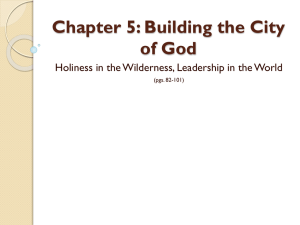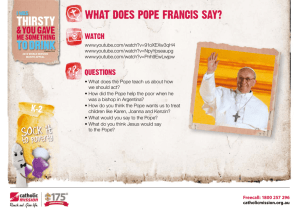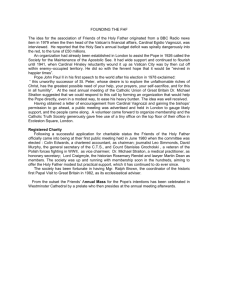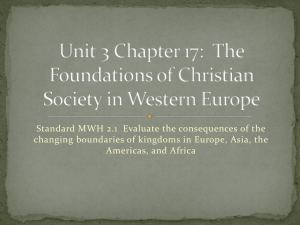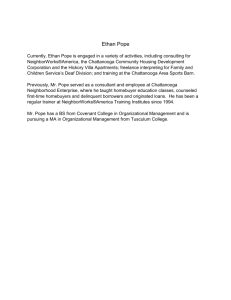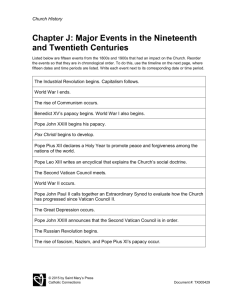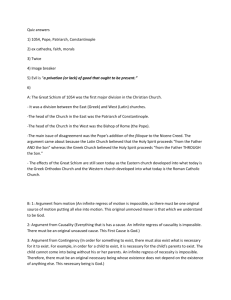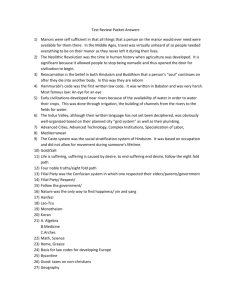GRADE 8 CHURCH HISTORY
advertisement
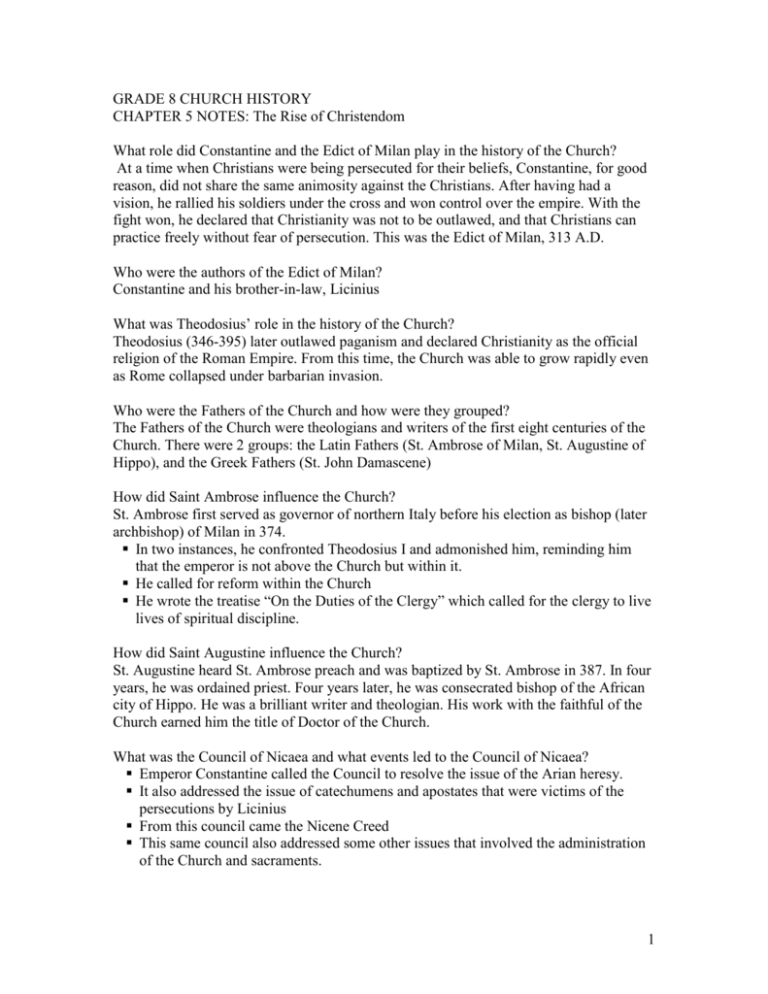
GRADE 8 CHURCH HISTORY CHAPTER 5 NOTES: The Rise of Christendom What role did Constantine and the Edict of Milan play in the history of the Church? At a time when Christians were being persecuted for their beliefs, Constantine, for good reason, did not share the same animosity against the Christians. After having had a vision, he rallied his soldiers under the cross and won control over the empire. With the fight won, he declared that Christianity was not to be outlawed, and that Christians can practice freely without fear of persecution. This was the Edict of Milan, 313 A.D. Who were the authors of the Edict of Milan? Constantine and his brother-in-law, Licinius What was Theodosius’ role in the history of the Church? Theodosius (346-395) later outlawed paganism and declared Christianity as the official religion of the Roman Empire. From this time, the Church was able to grow rapidly even as Rome collapsed under barbarian invasion. Who were the Fathers of the Church and how were they grouped? The Fathers of the Church were theologians and writers of the first eight centuries of the Church. There were 2 groups: the Latin Fathers (St. Ambrose of Milan, St. Augustine of Hippo), and the Greek Fathers (St. John Damascene) How did Saint Ambrose influence the Church? St. Ambrose first served as governor of northern Italy before his election as bishop (later archbishop) of Milan in 374. In two instances, he confronted Theodosius I and admonished him, reminding him that the emperor is not above the Church but within it. He called for reform within the Church He wrote the treatise “On the Duties of the Clergy” which called for the clergy to live lives of spiritual discipline. How did Saint Augustine influence the Church? St. Augustine heard St. Ambrose preach and was baptized by St. Ambrose in 387. In four years, he was ordained priest. Four years later, he was consecrated bishop of the African city of Hippo. He was a brilliant writer and theologian. His work with the faithful of the Church earned him the title of Doctor of the Church. What was the Council of Nicaea and what events led to the Council of Nicaea? Emperor Constantine called the Council to resolve the issue of the Arian heresy. It also addressed the issue of catechumens and apostates that were victims of the persecutions by Licinius From this council came the Nicene Creed This same council also addressed some other issues that involved the administration of the Church and sacraments. 1 Define ‘papacy.’ Papacy is the name and position of leadership, the office and authority of the pope. What does the CCC 937 refer to about papal authority? The pope enjoys, by divine institution, ‘supreme, full, immediate, and universal power in the care of souls.’ CCC 937. Define the meaning of ‘Christendom.’ Christendom refers to the growth of the Church in territory and in both temporal or political, and spiritual authority resulting in the Pope’s authority exceeding that of the emperor and eventually that of the kings, in the West Discuss briefly the life of Pope Saint Sylvester I. Pope St. Sylvester I was pope from 314 to 335. He was the symbol of the Church with its new freedom from persecution. Sylvester oversaw the building of two basilicas: the Basilica of St. Peter, and the Basilica of St. John Lateran both in Rome. What is the meaning of the word ‘pope’ and how did this come about? The word Pope means ‘father’ and it was during the pontificate of Sylvester that the bishop of Rome was referred to as Pope. Before this time, the title pope was given to any influential bishop. It was after this time that the title pope was referred to only the bishop of Rome. Discuss briefly the life of Pope Saint Leo the Great and his role in the life of the Church in the 4th century. Pope St. Leo the Great began his papacy in 440. He was a great preacher and defender of the Church. He took seriously the primacy of St. Peter that authority was given to Peter directly from Jesus himself. Therefore, following the apostolic authority given by succession, Pope Leo the Great asserted that authority in the Church and later over civil matters. Discuss how Pope St. Leo was able to save Rome from destruction. In 452, Pope Leo set out to meet with Attila the Hun, who had been leaving a path of destruction through Europe on his way toward Rome. Pope Leo was able to persuade Attila to turn around and avoid the invasion of Rome. Another time, in 455, Leo again saved Rome from being burned to the ground by meeting with Genseric the Vandal who had sacked the great city. What is the Church in relation to the Holy Spirit? The Church is both visible and spiritual. God the Father is her author; Christ is her bridegroom; and she is the Temple of the Holy Spirit. She is the sacrament of the Holy Trinity’s communion with humanity. Define ‘monasticism.’ Monasticism is a way of living the Gospel in which men and women live in community and devote themselves to prayer, work, and learning. 2 What is monasticism centered on? Monasticism is centered on prayer, work, fasting, and learning. It guides its members to live in community that live out the Gospel teachings of obedience, poverty, chastity, and simplicity. Who were some of the leaders of monasticism? They were St. Martin of Tours, St. Benedict, and St. Scholastica. St. Benedict is the founder of monasticism in the Church in the West. Discuss the ‘Rule of St. Benedict.’ The ‘Rule of St. Benedict’ was the guide that was used by the monks in monasteries founded by Benedict and by the nuns in the convents founded by St. Scholastica What is ‘renewal?’ A renewal is used by people within an organization who are dedicated to making sure that an organization is living by its values and achieving the goals for which it was founded. How did the renewal of monasticism help the Church? Renewal in monasticism helped throughout the history of the Church by helping people deepen their spiritual life. In the 10th through 11th centuries, the monasteries of Cluny and Clairvaux became important places that spear-headed renewal in monasticism. How are the Church, the Holy Spirit, and Jesus co-partners in the divine plan of salvation? The Church is the Body of Christ. The Church is the Bride of Christ. It is also the Temple of the Holy Spirit, working in the world to build up the Church on earth. The work of Christ and the Holy Spirit is inseparable, always working together to bring the plan of salvation for the world. It is said that the Church is not simply a building; so what makes the Church? The Church is the 1) People of God, 2) the Body of Christ, 3) and the Temple of the Holy Spirit. We are members of that Body and we are all called to be a herald of the Gospel. The Holy Spirit constantly works in us, through us, and for us. What is a ‘charism?’ Charisms are special graces given to us that help us to be active and vibrant members of the Church. What qualities make a good leader? Some people are born leaders. Others learn to become leaders as they develop their full potential as leaders. A good and effective leader: Encourages others to make full potential of their talents; they are a positive influence on others. 3 Expresses their ideas and listens attentively as others express their ideas or opinions; they use effective communication skills. Are patient and persistent, knowing that it takes patience, and sacrifice to get the right things done. Shows compassion and respect for others. Have integrity, honesty, dependability, and trustworthiness Recognizes their own limitations View problems as opportunities and challenges. 4
